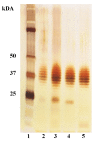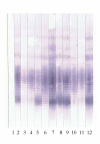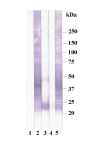Use of a Western blot technique for the serodiagnosis of glanders
- PMID: 21247488
- PMCID: PMC3034690
- DOI: 10.1186/1746-6148-7-4
Use of a Western blot technique for the serodiagnosis of glanders
Abstract
Background: The in vivo diagnosis of glanders relies on the highly sensitive complement fixation test (CFT). Frequently observed false positive results are troublesome for veterinary authorities and cause financial losses to animal owners. Consequently, there is an urgent need to develop a test with high specificity. Hence, a Western blot assay making use of a partly purified lipopolysaccaride (LPS) containing antigen of three Burkholderia mallei strains was developed. The test was validated investigating a comprehensive set of positive and negative sera obtained from horses and mules from endemic and non endemic areas.
Results: The developed Western blot assay showed a markedly higher diagnostic specificity when compared to the prescribed CFT and therefore can be used as a confirmatory test. However, the CFT remains the test of choice for routine testing of glanders due to its high sensitivity, its feasibility using standard laboratory equipment and its worldwide distribution in diagnostic laboratories.
Conclusions: The CFT should be amended by the newly validated Western blot to increase the positive likelihood ratio of glanders serodiagnosis in non endemic areas or areas with low glanders prevalence. Its use for international trade of horses and mules should be implemented by the OIE.
Figures




Similar articles
-
Designing of Western Blot Technique for Glanders Diagnosing in Iran.J Equine Vet Sci. 2021 Apr;99:103403. doi: 10.1016/j.jevs.2021.103403. Epub 2021 Feb 3. J Equine Vet Sci. 2021. PMID: 33781425
-
Evaluation of the comparative accuracy of the complement fixation test, Western blot and five enzyme-linked immunosorbent assays for serodiagnosis of glanders.PLoS One. 2019 Apr 5;14(4):e0214963. doi: 10.1371/journal.pone.0214963. eCollection 2019. PLoS One. 2019. PMID: 30951554 Free PMC article.
-
Interlaboratory ring trial to evaluate CFT proficiency of European laboratories for diagnosis of glanders in equids.Vet Rec. 2016 Jun 18;178(25):632. doi: 10.1136/vr.103617. Epub 2016 Apr 27. Vet Rec. 2016. PMID: 27122499
-
Glanders and the risk for its introduction through the international movement of horses.Equine Vet J. 2016 Sep;48(5):654-8. doi: 10.1111/evj.12599. Epub 2016 Jul 22. Equine Vet J. 2016. PMID: 27288893 Review.
-
Glanders in animals: a review on epidemiology, clinical presentation, diagnosis and countermeasures.Transbound Emerg Dis. 2013 Jun;60(3):204-21. doi: 10.1111/j.1865-1682.2012.01342.x. Epub 2012 May 27. Transbound Emerg Dis. 2013. PMID: 22630609 Review.
Cited by
-
Validation of a Commercial Glanders ELISA as an Alternative to the CFT in International Trade of Equidae.Front Vet Sci. 2021 Feb 16;8:628389. doi: 10.3389/fvets.2021.628389. eCollection 2021. Front Vet Sci. 2021. PMID: 33665218 Free PMC article.
-
Use of a recombinant burkholderia intracellular motility a protein for immunodiagnosis of glanders.Clin Vaccine Immunol. 2011 Sep;18(9):1456-61. doi: 10.1128/CVI.05185-11. Epub 2011 Jul 13. Clin Vaccine Immunol. 2011. PMID: 21752949 Free PMC article.
-
Protective antigens against glanders identified by expression library immunization.Front Microbiol. 2011 Nov 21;2:227. doi: 10.3389/fmicb.2011.00227. eCollection 2011. Front Microbiol. 2011. PMID: 22125550 Free PMC article.
-
Systematic monitoring of glanders-infected horses by complement fixation test, bacterial isolation, and PCR.Vet Anim Sci. 2020 Oct 6;10:100147. doi: 10.1016/j.vas.2020.100147. eCollection 2020 Dec. Vet Anim Sci. 2020. PMID: 33089006 Free PMC article.
-
Current and Future Advances in the Detection and Surveillance of Biosecurity-Relevant Equine Bacterial Diseases Using Loop-Mediated Isothermal Amplification (LAMP).Animals (Basel). 2023 Aug 18;13(16):2663. doi: 10.3390/ani13162663. Animals (Basel). 2023. PMID: 37627456 Free PMC article. Review.
References
-
- Bazargani TT, Tadjbakhs H, Badii A, Zahraei T. The outbreak of glanders in some racehorses in three states of Iran. J Eq Vet Sci. 1996;16:232–236. doi: 10.1016/S0737-0806(96)80188-2. - DOI
-
- Al-Ani FK, Al-Rawashdeh OF, Ali AH, Hassan FK. Glanders in horses - clinical, biochemical and serological studies in Iraq. Vet Arhiv. 1998;68:155–162.
-
- Muhammad G, Khan MZ, Athar M. Clinico-microbiological and therapeutic aspects of glanders in equines. J Equine Sci. 1998;9:93–96. doi: 10.1294/jes.9.93. - DOI
-
- Mota RA, Brito MF, Castro FJ, Massa M. Glanders in horses and mules of the states of Pernambuco and Alagoas, Brazil. Pes Vet Bras. 2000;20:155–159.
Publication types
MeSH terms
Substances
LinkOut - more resources
Full Text Sources
Other Literature Sources
Molecular Biology Databases

